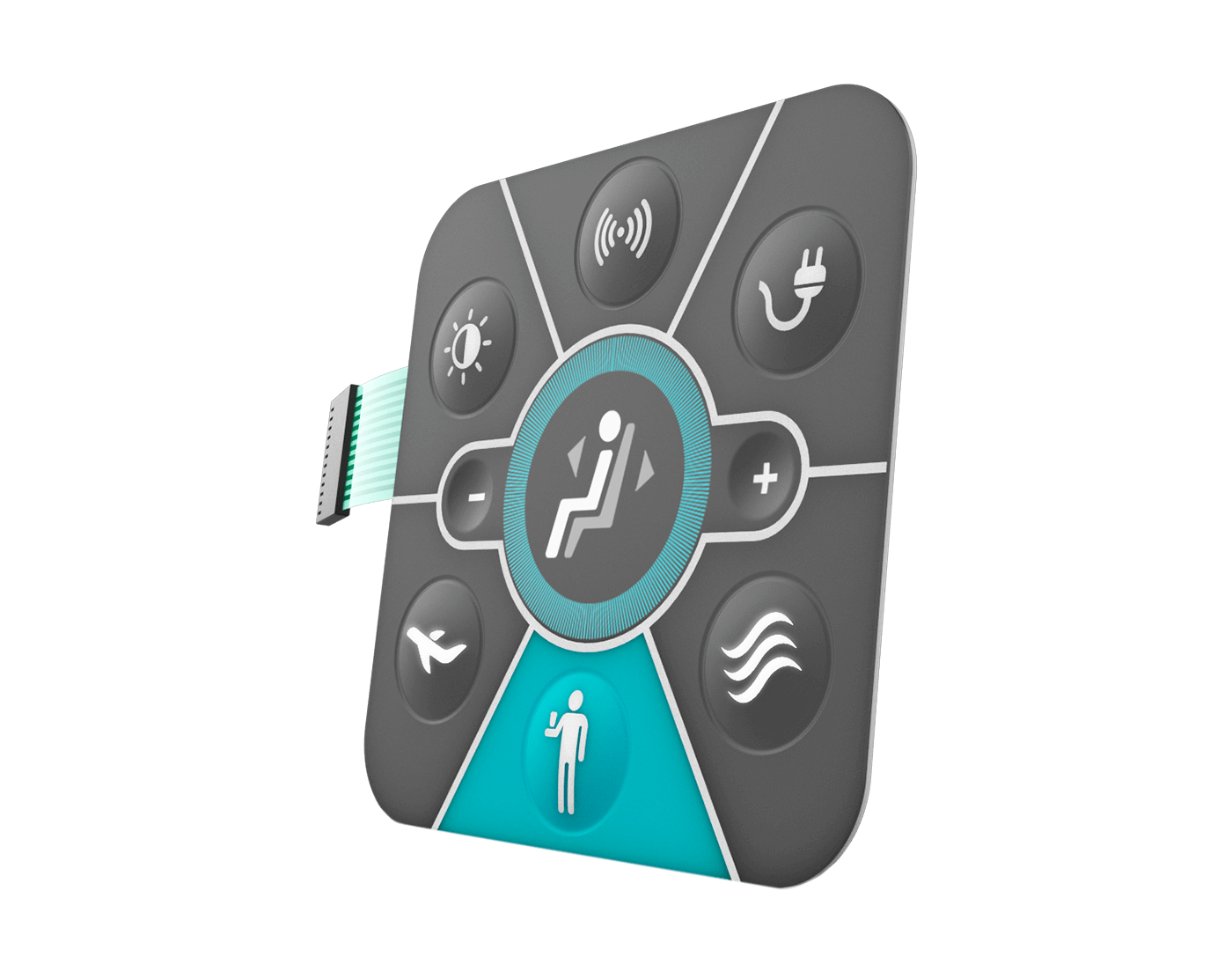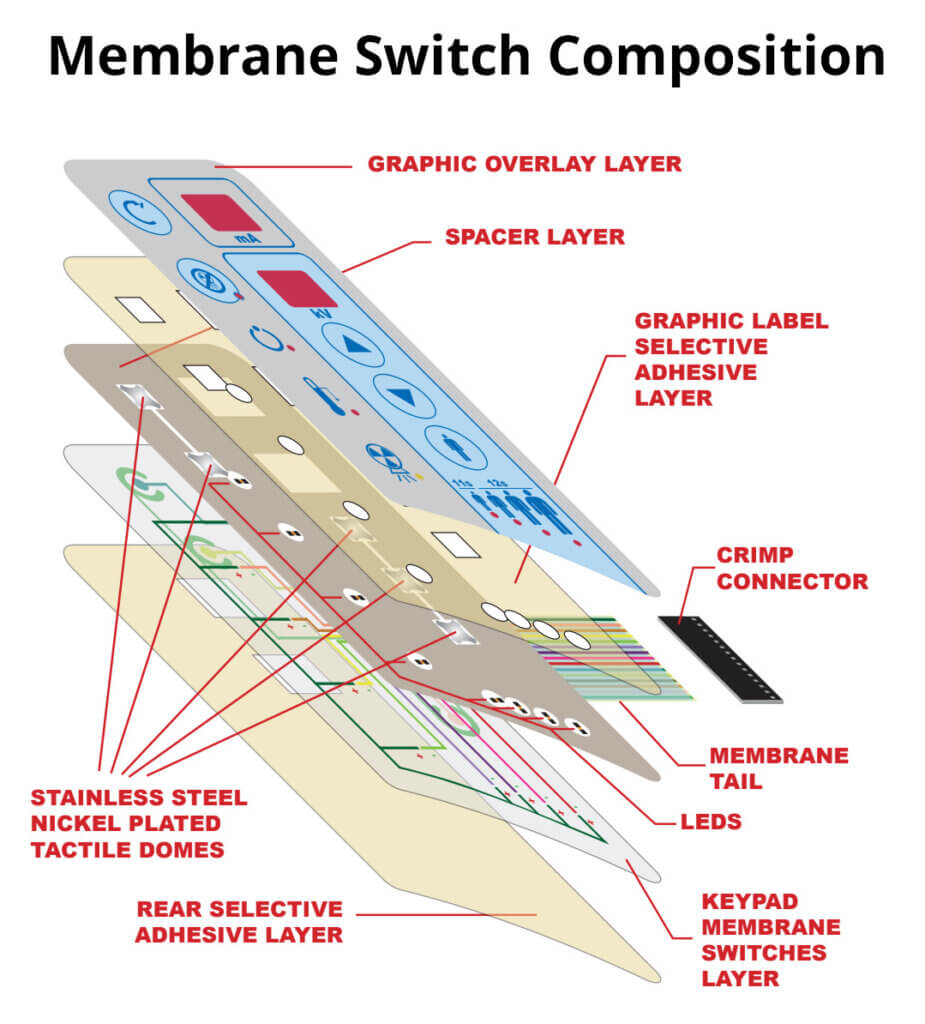Membrane Switch Manufacturer Serving Hospital and Aerospace Industries
Membrane Switch Manufacturer Serving Hospital and Aerospace Industries
Blog Article
Understanding the Relevance of Membrane Switch in Modern Electronics and Their Applications
Membrane changes act as an essential element in modern-day electronic devices, providing an effective user interface for customer interaction. Their light-weight and customizable nature makes them appropriate for a variety of applications across diverse sectors. Comprehending their key components and benefits can offer insights into their expanding importance. As innovation proceeds to development, the advancement of Membrane switches questions regarding their future applications and design innovations. What exists ahead in this vibrant area?

What Are Membrane Switches?
Membrane switches are important parts in modern electronics, acting as customer interfaces that assist in communication between users and gadgets. These switches consist of numerous layers, including a visuals overlay, a glue layer, and a circuit layer, every one of which collaborate to produce a sturdy and useful interface. The style permits for a flat, inconspicuous option that can be tailored regarding size, shape, and aesthetic look, making them suitable for various applications, from customer electronic devices to clinical gadgets. The tactile responses provided by Membrane changes boosts customer experience, while their resistance to dirt and wetness makes them ideal for testing settings. Furthermore, Membrane switches can integrate functions such as backlighting and printed graphics, further broadening their usability. Their convenience and effectiveness make them a recommended selection in markets where integrity and ease of usage are vital, eventually contributing to the seamless procedure of contemporary digital tools.
Key Components of Membrane Switches Over
While numerous components add to the capability of a membrane button, three main layers play significant duties in its design and operation. The top layer, normally made from a long lasting polymer, offers as the user interface for user communication, typically including published symbols and graphics. Under this is the spacer layer, which keeps the needed range between the top layer and the circuit layer. This spacer layer assurances that the switch triggers only when pushed, protecting against unintentional inputs. The circuit layer includes conductive traces that finish the electrical circuit when the top layer is depressed. These traces can be made from various materials, consisting of copper or silver. With each other, these elements develop a dependable and robust gadget that is portable and functional, suitable for a variety of digital applications, from family appliances to clinical gadgets. Recognizing these crucial components is crucial for appreciating the total functionality of Membrane switches.
Benefits of Utilizing Membrane Switches Over

Membrane Switch Manufacturing Refine
Comprehending the Membrane button production process exposes the detailed steps included in generating these essential components. The procedure typically begins with the style phase, where specs and layouts are created making use of specialized software. Following this, the graphic overlay is printed on an adaptable substratum, often making use of high-resolution printing techniques to assure clearness and precision.Next, the adhesive layers are applied, which offer to bond the various parts together. The circuit layers, made from conductive inks or products, are after that printed onto a separate substratum. These layers are meticulously lined up and laminated to create a functional switch.After setting up, the switches undergo examining to verify capability and resilience. Quality control steps are applied throughout the process to identify and correct any kind of defects. The completed Membrane switches are packaged and prepared for distribution, prepared to meet the demands of modern digital applications.
Applications of Membrane Switches Over in Various Industries
Membrane buttons are progressively used throughout different industries, specifically in clinical devices and customer electronic devices. In the medical area, they supply reliable control interfaces for gadgets that require exact procedure. In customer electronic devices, these buttons improve customer communication by supplying sleek and responsive user interfaces. Receptive Medical Tools Control
Many modern-day medical devices use Membrane buttons for structured procedure and enhanced user interaction. These buttons supply a reliable, long lasting user interface for a selection of applications, including analysis devices, client monitoring systems, and medical tools. Their personalized designs enable specific formats that can suit the special requirements of health care specialists, making sure user-friendly navigation and reliable access to important features. find more information In addition, Membrane switches are immune to view pollutants, making them appropriate for sterilized settings. The tactile feedback they provide can improve user self-confidence, reducing the risk of mistakes throughout crucial medical procedures. On the whole, the assimilation of Membrane switches in clinical devices greatly adds to improved functional effectiveness and patient security in healthcare setups.
Customer Electronic Devices Interfaces
In the domain name of customer electronics, Membrane switches play a critical duty in enhancing interface throughout a broad range of devices. These buttons are indispensable to items such as remote controls, microwaves, and gaming consoles, providing a easy to use and reliable interface. Their design enables a smooth combination of graphics and capability, making it possible for manufacturers to develop streamlined, contemporary appearances without jeopardizing use. Membrane buttons are also understood for their durability, frequently withstanding extensive usage and exposure to numerous environmental conditions. In addition, they can incorporate features like backlighting and responsive comments, further improving the user experience. As customer needs for advanced yet intuitive user interfaces expand, Membrane switches continue to be a vital part ahead of time digital gadget performance.
Design Considerations for Membrane Switches Over
Designing reliable Membrane switches calls for careful focus to various aspects that influence both capability and individual experience. One essential factor to consider is the choice of products, as they can affect longevity, tactile comments, and aesthetic charm. Choosing an appropriate adhesive is crucial for ensuring lasting bond and resistance to environmental factors.In enhancement, the format and layout of the switch need to suit user communication, with button dimensions and spacing optimized for convenience of use. The consolidation of graphics and labeling should focus on clearness and visibility under various lighting conditions.Consideration of electric characteristics, such as actuation force and switch sensitivity, will certainly improve the responsiveness of the Membrane switch. Furthermore, the style should accommodate making processes to assure cost-effectiveness and timely manufacturing. Generally, a well-thought-out design improves both the performance and the individual experience of Membrane switches in modern electronics.

Future Fads in Membrane Switch Modern Technology
As technology remains to develop, Membrane switches are poised to integrate brand-new advancements that will certainly enhance their capability and application read in numerous fields. One significant trend is the unification of durable and adaptable products, which will raise the lifespan and integrity of these buttons. Improved surface appearances and personalized graphics are likewise anticipated, permitting for even more intuitive individual interfaces.Moreover, the combination of wise innovation, such as touch-sensitive surface areas and haptic comments, is anticipated to enhance user communication, making Membrane switches much more responsive and interesting. In addition, advancements in published electronic devices will make it possible for much more intricate wiring within thinner profiles, additionally increasing design possibilities.Sustainability will additionally play a vital role in future advancements, as suppliers explore eco-friendly materials and manufacturing processes. On the whole, these trends will certainly ensure that Membrane switches stay important and relevant in an interconnected and progressively digital world.
Often Asked Inquiries
Exactly How Do Membrane Changes Compare to Conventional Mechanical Switches?
Membrane changes offer benefits over conventional mechanical buttons, consisting of reduced size, lighter weight, and improved sturdiness. They typically supply a sealed surface area, boosting resistance to dust and dampness, making them excellent for diverse applications.
What Products Are Typically Made Use Of in Membrane Switch Building And Construction?

Can Membrane Changes Withstand Extreme Environmental Issues?
Membrane buttons can endure extreme environmental problems, relying on their layout and products. Top quality building and constructions frequently include durability versus temperature variations, moisture, and direct exposure to chemicals, making them suitable for different requiring applications throughout sectors.
The Length Of Time Do Membrane Switches Normally Last Prior To Failure?
Membrane switches over commonly exhibit a life expectancy ranging from 1 to 10 million actuations, depending upon aspects such as use regularity, environmental problems, and producing high quality. Routine upkeep can extend their resilience and functional reliability considerably.
Are Membrane Changes Personalized for Particular Applications?
Membrane switches are without a doubt customizable for details applications. They can be tailored in style, size, and performance, permitting manufacturers to satisfy special individual demands and boost item aesthetics while keeping operational efficiency and resilience. Membrane buttons are essential parts in contemporary electronic devices, offering as customer interfaces that facilitate communication between tools and individuals. The tactile responses supplied by Membrane switches enhances user experience, while their resistance to dust and wetness makes them optimal for challenging environments. The consolidation of graphics and labeling need to focus on quality and presence under numerous lights conditions.Consideration of electric qualities, such as actuation pressure and switch sensitivity, will enhance the responsiveness of the Membrane switch. Enhanced surface structures and customizable graphics are additionally anticipated, allowing for even more instinctive customer interfaces.Moreover, the combination of smart technology, such as touch-sensitive surfaces and haptic feedback, is anticipated to enhance individual communication, making Membrane switches over a lot more receptive and appealing. Membrane switches offer benefits over traditional mechanical buttons, including lowered size, lighter weight, and enhanced durability.
Report this page